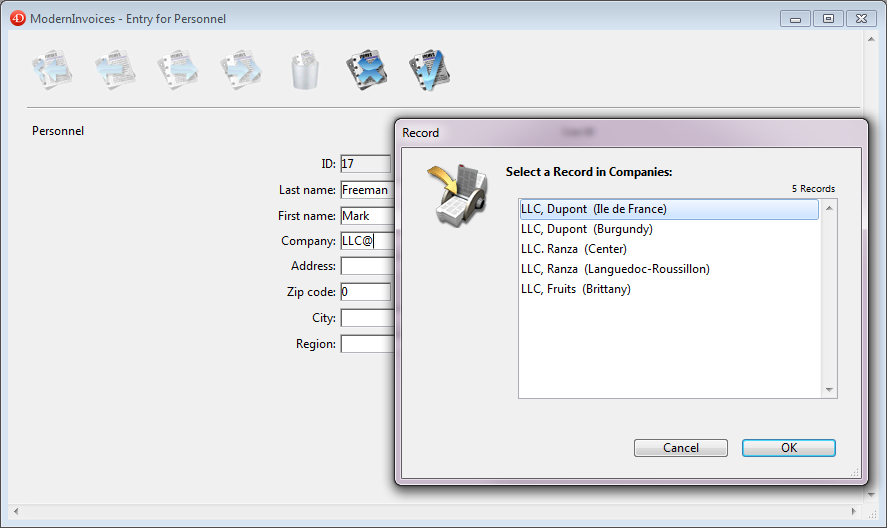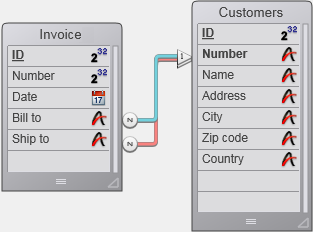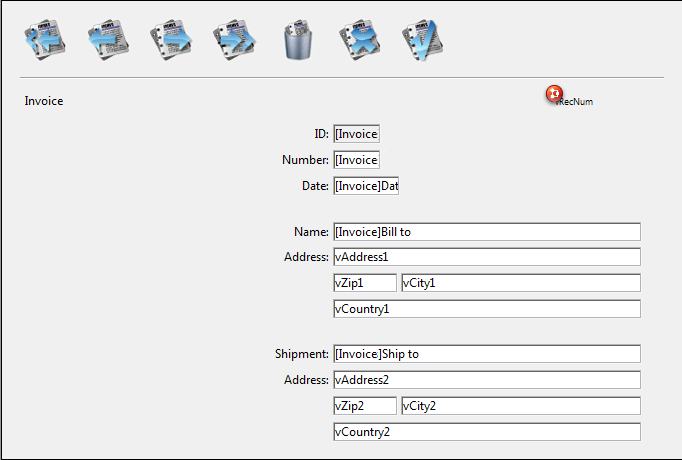4D v16.3
RELATE ONE
 RELATE ONE
RELATE ONE
| RELATE ONE ( manyTable | Field {; choiceField} ) | ||||||||
| Parameter | Type | Description | ||||||
| manyTable | Field | Table, Field |

|
Table for which to establish all automatic relations, or Field with manual relation to one table | |||||
| choiceField | Field |

|
Choice field from the one table | |||||
RELATE ONE has two forms.
The first form, RELATE ONE(manyTable), establishes all automatic Many-to-One relations for manyTable in the current process. This means that for each field in manyTable that has an automatic Many-to-One relation, the command will select the related record in each related table. This changes the current record in the related tables for the process.
The second form, RELATE ONE(manyField{;choiceField}), looks for the record related to manyField. The relation does not need to be automatic. If it exists, RELATE ONE loads the related record into memory, making it the current record and current selection for its table.
The optional choiceField parameter must be a field in the related table. It can only be an Alpha, Text, Numeric, Date, Time, or Boolean field. More specifically, it cannot be a Picture or BLOB type field.
If choiceField is specified and more than one record is found in the related table, RELATE ONE displays a list of records that match the value in manyField so that the user can select a record. In this list, the left column displays related field values, and the right column displays choiceField values.
More than one record may be found if manyField ends with the wildcard character (@). If there is only one match, the list does not appear.
In the screen below, a record is being entered and a selection list is displayed in the foreground.

The following command is used to make the selection list appear:
RELATE ONE([Personnel]Company;[Companies]Region)A user entered LLC@ to see a list of companies whose names begin with LLC, as well as their region.
Specifying choiceField is the same as specifying a wildcard choice when establishing the table relation. For information about specifying a wildcard choice, refer to the 4D Design Reference manual.
Note: This command does not support Object type fields.
Let’s say you have an [Invoice] table related to a [Customers] table with two non-automatic relations. One relation is from [Invoice]Bill to to [Customers]Number, and the other relation is from [Invoice]Ship to to [Customers]Number.

Here is the form for the [Invoice] table displaying the "Bill to" and "Send to" information:

Since both relations are to the same table, [Customers], you cannot obtain the billing and shipment information at the same time. Therefore, displaying both addresses in a form should be performed using variables and calls to RELATE ONE. If the [Customers] fields were displayed instead, data from only one of the relations would be displayed.
The following two methods are the object methods for the [Invoice]Bill to and [Invoice]Ship to fields. They are executed when the fields are entered.
Here is the object method for the [Invoice]Bill to field:
RELATE ONE([Invoice]Bill to)
vAddress1:=[Customers]Address
vCity1:=[Customers]City
vState1:=[Customers]State
vZIP1:=[Customers]ZIPHere is the object method for the [Invoice]Ship to field:
RELATE ONE([Invoice]Ship to)
vAddress2:=[Customers]Address
vCity2:=[Customers]City
vState2:=[Customers]State
vZIP2:=[Customers]ZIPIf the command has been executed correctly and if the related records have been loaded, the OK system variable is set to 1. If the user clicked on Cancel in the record selection dialog box (that appears when the related record has been modified), the
Product: 4D
Theme: Relations
Number:
42
Modified: 4D v11 SQL
4D Language Reference ( 4D v16)
4D Language Reference ( 4D v16.1)
4D Language Reference ( 4D v16.2)
4D Language Reference ( 4D v16.3)












